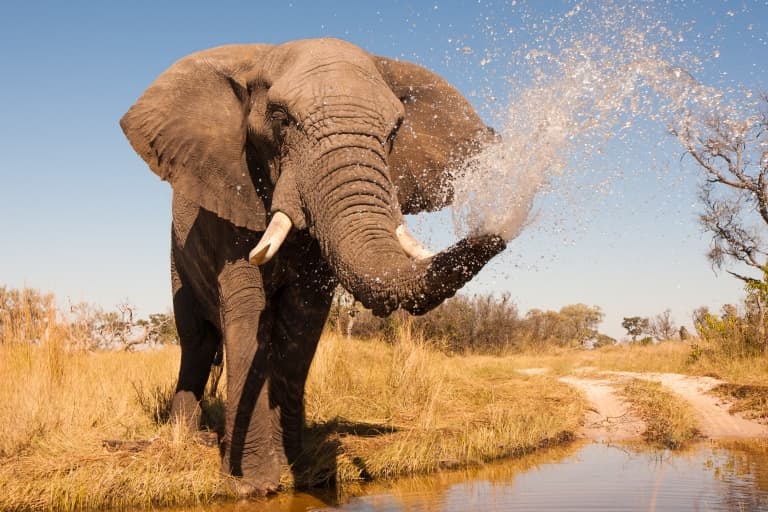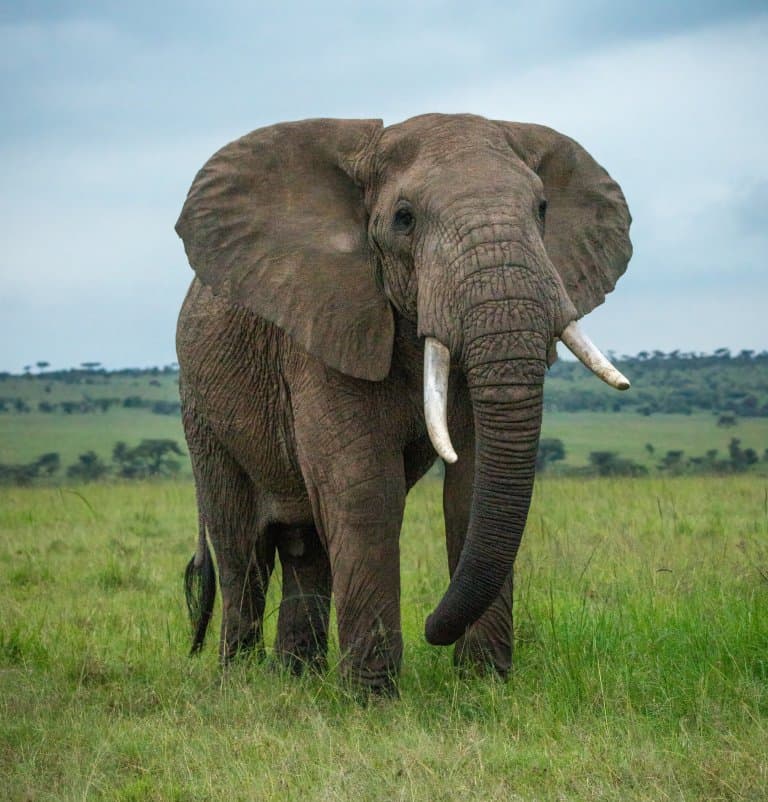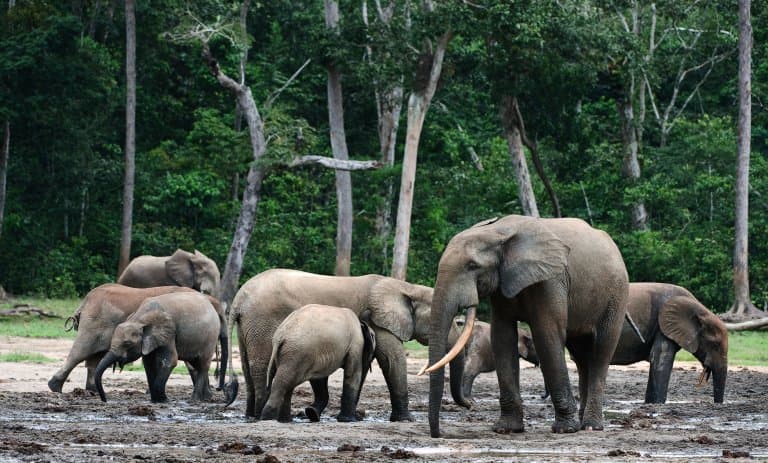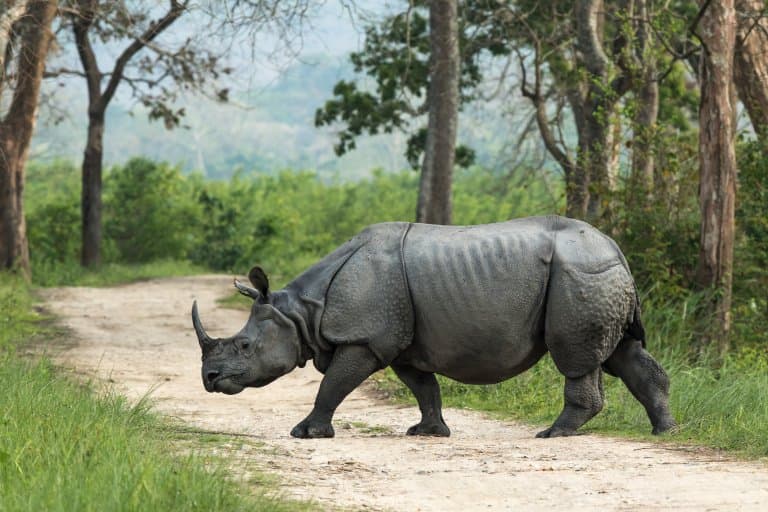Large can be a misleading word. Some people, for example, have a circumference that exceeds their length, necessitating the use of more precise, scientific metrics such as ‘fat’ or ‘lanky’ to add a more useful dimension to what is ‘large’.
Volume and density measures are often good when comparing the size of things, but anything more complex than a sphere or a cube starts to get very difficult to calculate, and there aren’t many animals that fit that description.
One thing that all animals on Earth have in common is the gravitational pull of the Earth (even this, if you really want to be pedantic, will vary depending on the altitude of the animal being measured, but not by enough to matter).
So, in the interests of consistency, this is a list of the largest animals on land, by weight.

Top 10 Largest Land Animals
It should come as no surprise that all of the animals on this list are mammals.
Mammals are still both the fattest and the lankiest creatures to walk on the planet, by far – even though the largest of them all (on land) have mostly died out.
What’s left is often heavily protected against poaching, and not always successfully so.
Still, humans have done their bit to wipe out over 96% of all large mammal species in the last 100,000 years or so, and show no sign of slowing down, so for them to have survived this long makes them exceptional.
1. African Bush Elephant (10,400 kg / 23,000 lb)
Currently, the largest land animal on earth is also one of the most endangered. Despite surviving the evolution of the existence of Homo sapiens so far, there’s a chance that the reign of the planet’s last truly mega fauna is coming to an end.
The largest elephant ever recorded was never polite enough to stand on the scales, but its mass is inferred from its height and plenty of available data to cross-reference.
This four-meter-tall giant is expected to have weighed around 10.4 metric tonnes. To put this in perspective, its extinct Asian relative from the Pleistocene might have weighed 22 tonnes (though this is inferred from a single femur)!
However, a 10-tonne monster isn’t common, and the average is much closer to 5,000kg, up to around 7,000kg in adult males. The largest individuals are targeted by smooth-brained individuals with guns for sport, so the species as a whole is getting smaller.
While the extinction of the mammoths may or may not be attributed to primitive human hunting practices, the extinction of modern elephants most certainly can.
Elephants are now mostly killed for their tusks, a material that has no value outside of the aesthetic and serves no purpose other than as a crude demonstration of opulence. 1

2. Asian Elephant (4,000 kg / 8,800 lb)
Modern-day Asian relatives, (both elephant and human), average a much lower body mass than their foreign counterparts, but they still have the capacity to squash you if you leave the fridge door open.
Some estimates of the maximum weight of this animal come from some of the most biased sources you can find: the Maharajah of Susang, in Assam.
In a display of classic human malfunction, the word of a trophy hunting despot has been taken without question and records of a 7,000kg bull elephant, shot in 1924, seem to have propagated successfully.
Whether this is the only example in the history of the world of a politician making accurate claims about their capabilities, or simply a porkie-pie invented to make him look good is impossible to know but effortless to speculate upon.
What we do know, is that individuals of well over 4,000kg have been reliably inferred by people with a lot less incentive to make it up, and some outlier data suggests that they can reach around 4,400kg. 2

3. African Forest Elephant (4,000 kg / 8,800 lb)
The only other surviving species of elephant in Africa is even more endangered. If there’s one thing more destructive than poaching, it’s habitat loss, and as a forest elephant, there are fewer and fewer available habitats for this species.
As with almost everywhere else on earth, rich, biodiverse swathes of forest have been removed, mostly for animal agriculture and the crops those animals require.
While the sheer size and relative poverty of the continent had kept numbers down until recently, the continent with the largest diversity of megafauna is hurtling toward a state of modernity and bringing with it all of the destruction associated with that.
Forest elephants are critically endangered, slightly smaller versions of their bush brothers, but still exceptionally large and dangerous.
They average around 2,000kg to 4,000kg, but it’s thought that they can get much heavier if they’re left alone for a while. Whether the maximum weight of the forest elephant is greater than the Asian elephant is uncertain. 3

4. Hippo (3,600 kg / 7,900 lb)
One of the most feared animals on earth is also one of the largest. Hippopotamus amphibius is said to be responsible for 500 deaths a year, and most of these are caused by opportunistic fishermen getting too close to them in the water at night.
Hippos are certainly powerful. Their enormous heads have skulls weighing hundreds of kilos, attached to gratuitous teeth and exceptional musculature. They have a bite strength that’s roughly three times that of a lion’s, which they use for fighting and for brutally attacking savanna grasses after dark.
Though they’re mostly into plants, like most other herbivores, they will have a go at some meat if given the chance, and they’re generally quite grumpy animals, so it’s best to give them a wide berth if you happen to be made of meat (or grass). These are relatively dangerous animals but are still quite navigable in areas where they’re familiar with human presence.
Hippos are thought to be the closest relative of a missing link between land mammals and whales.
While every animal on Earth began as a marine animal, all mammals evolved on land, and afterwards, some migrated back into the oceans and became whales. Hippos reflect a transitional state between the two, and even use echolocation, like their marine cousins. 4

5. White Rhinoceros (2,400 kg / 5,300 lb)
Rhinos, despite their terrifying appearance and tetchy temperament, are adorable herbivores under significant threat from poaching.
The Northern white rhino population has dropped into the low tens and is still being hunted for their horns, which are made of keratin and have no significant medicinal value beyond placebo.
The Southern population is doing a little better, at around 1,800 individuals, but the species is listed as Near Threatened and declining by the IUCN.
Rhinos can’t see very well, and that does tend to make them grumpy, but of all the dangerous animals in Africa, rhinos aren’t close to the top of the list.
These are emotionally intelligent and playful animals, capable of zoomies, and they’re the larger species of the two found on the Continent. The name comes from the Afrikaans for ‘wide’ which refers to their mouths. As grazers, they have a flat, wide mouth for nibbling on grass. 5
6. Indian Rhinoceros (2,300 kg / 5,070 lb)
This is another crafty animal to weigh, and there are several unsourced claims that they can reach much higher digits than any primary literature or reliable source seems to support.
However, responsible zoos are relatively reliable when it comes to the weights of their animals (though their websites often aren’t), and adult males are regularly recorded at weights of up to 2,300kg, with seemingly unsupported claims of them reaching up to 2,700kg+, which would make them heavier than the average white rhino.
Again, these animals are commonly shot for their horn, and while they’re consequently listed as vulnerable by the IUCN, their population is finally increasing after concentrated conservation efforts.
Indian rhinos number around 4,000, which still isn’t many, and the long gestation periods of 16 to 18 months make them particularly slow to recover. 6

7. Black Rhinoceros (1,300 kg / 2,866 lb)
A 1966 paper listed a top weight of 2,866lb, which was then erroneously cited in kilograms in the Mammalian Species journal in 1994.
A much more realistic range leads to around 1,200kg for the black rhino, with 1,300kg representing close to the upper bound for weight. This error highlights the pressing need to both check sources carefully and abolish the imperial system forever.
Black Rhinos are browsers, and because of this, they have prehensile upper lips, like a miniature trunk, for gripping bushy foliage and pulling it off the plant to eat. 7

8. Rothschild Giraffe (1,300 kg / 2,866 lb)
Now we come to the lankiest of all the mammals, and one which is a little easier to find data on.
Giraffes are enormous, so it’s hardly a surprise that they’re one of the heaviest animals on land. Our data is for the Rothschild giraffe, but it’s thought that the Masai subspecies is even bigger, so this could be bumped up to number 7 on the list.
It was once hypothesised by Darwin that giraffes evolved long necks to reach succulent morsels at the higher branches of trees, but recently, researchers found that this may not be the case. There are still several hypotheses floating around out there, but one of the more convincing is that the long neck is a sexually-selected characteristic, one that aids in fighting and vigilance.
It should be noted that if this were a list of the lankiest animals, the green anaconda might inch past the giraffe, but only if it were standing on the tip of its tail. 8

9. Javan Rhinoceros (1,000 – 1,200 kg / 2,645 lb)
So far, all of the top weights have come from male specimens. It’s almost universal that in mammals, males are the heavier of the sexes, though there are some exceptions.
In hyenas, the adult females are generally larger, and in the Javan rhino, there isn’t really a significant difference in size between males and females.
Both are large animals, though significantly smaller than their relatives listed above.
Exact weights are hard to come by as these animals are critically endangered with a population in the 70s, and as such expensive and difficult to study; the irony of which is that vital information that would aid their conservation is hard to retrieve.
The closest we have are estimates of around 1,000kg, but they’re commonly reported from semi-reliable sources as weighing up to 1,200kg.
Without better data, conservationists’ hands are somewhat tied, as weight ties into several valuable research metrics into their diet, behaviour, and physiology. 9

10. Bison (900 kg+ / 1,984 lb)
Bison weights are, perhaps unsurprisingly, exaggerated. Still, these are some hefty beings and mean weights are reliably recorded up to almost 900kg in some age groups in Badlands National Park.
This suggests there should be some outliers that break the tonne mark, putting them around the same weight as a giraffe, though with very different dimensions. If the giraffe is lanky, the bison is fat.
The AnimalDiversity.org website makes a bold claim that the European bison species reaches 1,000kg, despite it typically being smaller than its American cousin. To bank up this claim, it links to a German bitcoin market news site called Bison, with no apparent connection to the animal itself.
For now, we’ll stick to peer-reviewed literature on the topic, but if the financial information portal does have figures on European bison weights in its archive, we’ll gladly take them into consideration. 10

Final thoughts
Weight is an important characteristic of an animal. Birth weights, dung weights, seasonal discrepancies and population variance in weight all contribute to a wider understanding of the animal itself and how it functions in the ecosystem.
As you can see, most of the animals on this list are targets of poaching for one reason or another, and often simply because they are big. So, a deeper understanding of these factors helps aid in their conservation and prevent them from disappearing forever, like 90% of their ancestors.
Weights are hard to get, though. If you’ve ever tried to weigh a suitcase on your bathroom scales before a flight, you’ll understand why. With large mammals, this suitcase is also exceptionally dangerous and sometimes hiding in the depths of an ancient forest. Even animals in zoos can be difficult to weigh, and will probably be better fed and nourished than their wild counterparts.
Add to this that a sample of individuals may not represent the entire population accurately and that their weights will shift between Spring and Autumn, in relation to the availability of food, and you start to see why this information can be hard to acquire.
Finally, weights recorded a hundred years ago may no longer be valid, since the largest individuals are commonly the ones that very bad people kill to display on their walls, reducing the average size of the populations overall.
Ultimately, there’s more to this data than simply a list of world records. An animal’s weight tells you a lot about what it does and how to help it.
Having said that, there may be data that we’ve missed. Can you find reliable sources?
Let us know if there are any weights you think we got wrong and can back them up with legitimate research to help us keep our information up to date!
Fact Sources & References
- Larramendi, A. (2016), “Shoulder height, body mass, and shape of proboscideans“, Acta Palaeontologica Polonica.
- R SUKUMAR, N V JOSHI and V KRISHNAMURTHY (1988), “Growth in the Asian elephant“, Indian Institute of Science.
- Grubb, P., Groves, C. P., Dudley, J. P., & Shoshani, J. (2000), “Living African elephants belong to two species: Loxodonta africana (Blumenbach, 1797) and Loxodonta cyclotis (Matschie, 1900)“, DigitalCommons.
- Moustafa M Haddara (2020), “Hippopotamus bite morbidity: a report of 11 cases from Burundi“, National Library of Medicine.
- Hillman-Smith, A. K. K., Owen-Smith, N., Anderson, J. L., Hall-Martin, A. J., & Selaladi, J. P. (2009), “Age estimation of the White rhinoceros (Ceratotherium simum)“, Journal of Zoology.
- Samuel Zschokke (2023), “Inbreeding, outbreeding, infant growth, and size dimorphism in captive Indian rhinoceros (Rhinoceros unicornis)“, Canadian Journal of Zoology.
- C. A. W. GUGGISBERG (1966), “S.O.S. Rhino“, rhinoresourcecenter.com.
- Gloneková, M., Brandlová, K., Žáčková, M., Dobiášová, B., Pechrová, K., & Šimek, J. (2016), “The weight of Rothschild giraffe-Is it really well known?“, Zoo Biology.
- A R S Hariyadi et al (2019), “Analysis of 3,11-dihydroxy-CM profile for the indicator of stress on male Javan rhinoceros“, Earth and Environmental Science.
- Licht, D. S. (2016), “Bison Weights From National Parks in the Northern Great Plains“, Rangelands.
